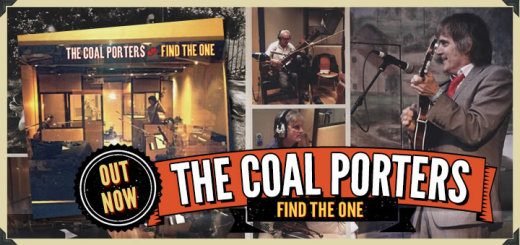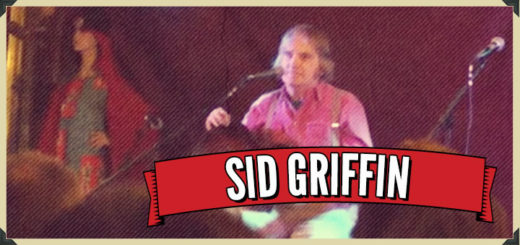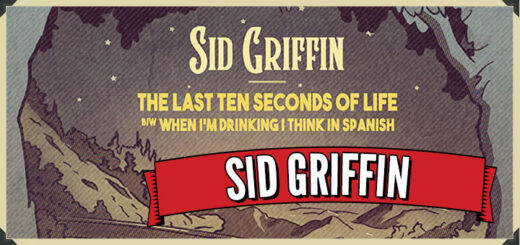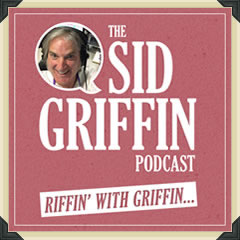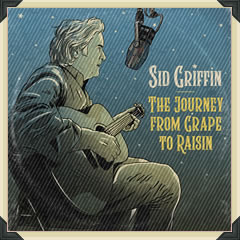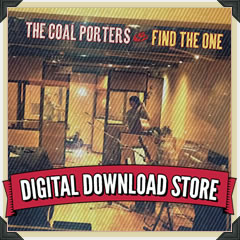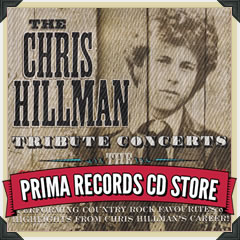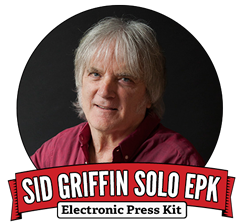The First Record I Ever Bought
First published on thevinyldistrict.com By Laurence Smith | November 12, 2012
Sid Griffin is the bandleader of Europe’s premier bluegrass outfit, the magnificent Coal Porters. The band are a joy to see live, as their show is a combination of top-level musicianship and high quality songs. A genuinely entertaining night is always guaranteed by Sid and crew, as they deliver an updated version of the old country shows in America’s rural south of the ‘40s and ‘50s. They return to London to play King’s Place in King’s Cross on Friday, November 23rd. Git yerselves down there y’all…
Sid popped into TVD London for a cup of tea and a chat last week, so we asked him to talk about his first record.
“My introduction to popular music pre-dates The Beatles. Born in 1955, I was not entirely healthy as a youngster and though I started school in autumn 1961 I was out of school more than I would liked to have been. I was home ill and in bed absent-mindedly watching black and white TV when President Kennedy was shot in Dallas and the announcement first came on the CBS television network. To this day I can tell you what commercial for what product was interrupted to make the announcement about the President and which CBS reporter’s face first came on screen to describe the situation. It is a memory I wish I could forget.
Resting in bed, I would listen to a transistor radio one of my parents got me to keep me company as I recuperated. It was black and battered, not much bigger than two packs of cigarettes placed side by side. The fidelity was terrible. When stereos shifted from relatively small all-in-one units to separate components in the late sixties, I was astonished to hear good, solid bass guitar and kick drum for the first time. They were completely inaudible on the little transistor I had.
But AM radio in the USA was a gift from God in the 1960s, a celestial gift. The only qualification for airplay was your record, your song had to be catchy. Hence the free-for-all which witnessed The Fab Four, Sinatra, Motown, novelty hits and, believe it or not, local acts all played on the hip local station. For some reason only C&W and gospel were excluded. And by the end of the decade music was formatted (read: segregated) by rock, MOR, R&B/Soul/Urban, and so on, never to reside shoulder to shoulder on the same station again.
The above means I am always amazed when someone asks me what my favourite record is or I see a list of what their favourite records are. For the first part, how can you pick one record? The new Uncut magazine has a quote from me stating “Turn Turn Turn” by the Byrds might be my fave of all time, but “might” is included in the quote and that is true, it might be. It might not be. And other folks’ lists are almost inevitably disappointing; a Beatles LP, something dull by Pink Floyd (the ultimate English public school boy act), Led Zeppelin pounding away to another headache, a token black/urban act, an indie group to prove the person picking the list still has a pulse and never any singles, just albums…’tis not for me.
My first privately owned record was an LP, yes an LP, Surfer Girl by the Beach Boys. My late Mother bought it for me for my birthday in 1963, the album coming out two days before. I still have this LP, beaten up though it may be. My first privately owned 45rpm single was a record by the Jalopy Five. I cannot remember the title on either side! The Jalopy Five were a 1960s group from nearby Nashville which recorded covers of current hits of the day for budget labels like Hit and Modern. This single was on Hit but that is all I remember. This 45 is long gone.
Most important to any record collector, any lover of music, is the first record they ever bought with their own money. It is like first love…whoever could possibly forget their first romance? Not me, and I pray not you either. The first record I ever owned which was purchased with my own money was the soundtrack to A Hard Day’s Night, the USA version with incidental instrumental music from the film included. It appeared on United Artist’s as film producer Walter Shenson demanded Brian Epstein give him and United Artist’s the soundtrack if the film deal was to be agreed. The late Shenson was worried the film might be crap and full of bad acting (as most rock films of the era were) but he was shrewd enough to know The Fab Four would put together some great original music for the their first flick. Which they did.
I was nine years old when A Hard Day’s Night appeared. Despite what you might have heard about Kentucky, I was not employed at such an age to go down the coal mines, although the stark reality was I had almost no money at all and almost no way to get any. My parents despised and loathed rock & roll music to an extent seen only in 1950s’ morality films like Blackboard Jungle, but to be fair they told me I could own a copy of A Hard Day’s Night if I bought it with my own money. But how to do that?
Beseeching my parents for ideas how to make money, they agreed to pay me a quarter for this, fifty cents for that, and so on. To mow the lawn with my Dad’s non-motorized, rotary blade mower was, I think, fifty cents (!) but remember this was 1964 and with a small flat lawn that was about right. (Before my Mom died she told me she paid a neighbourhood kid twenty bucks to cut our grass, the then going rate, yet on the same lawn I got fifty cents for. I about fainted.)
I began to work like a dog. Or so it seemed at the time. Like today record stores were not on every corner, that came with the explosion of Mom-and-Pop, hippie record shops in the late 1960s. In 1964, records were still as likely to be bought in the small record section of a large department store or at the corner drug store of a regional chain of pharmacies. This latter is where A Hard Day’s Night on United Artists was found in the front racks by a young Sid Griffin for something like $2.75 plus tax in mono, and around $3.40 plus tax for the stereo version. Many of my contemporaries at Chenoweth Elementary School bought mono LPs if they had the dough, but mainly we purchased 45rpm singles as they were affordable. But for my beloved Beatles I thought I would get this LP and get it in stereo, going full hog.
I worked in the back garden. I worked in the front yard. I mowed my grandma’s lawn pushing the rotary blades of the 1947 lawn mower till they hummed with a high pitched tone which was quite pleasing to suburban ears. I ran errands which were rewarded with the princely sum of a dime. Then I would buy a soda for a dime as it was hot that summer (A Hard Day’s Night was released by United Artists in June, 1964) and I would be back at even-steven for the afternoon. This was harder than I thought but it was my parents’ way; they wouldn’t buy me things they disapproved of, but would allow me to have them should I somehow be able to buy them with my own money. Fair enough.
At last, the grand moment arrived. By myself I walked to what we Americans call a drug store (much to the amusement of Brits) with enough money to buy a stereo LP of A Hard Day’s Night. I can distinctly remember that each LP had a staple, yes a metal staple (!), in the upper right hand corner with a white sticker stating the price in red and blue. Why this white sticker with red and blue ink could not have been applied to the LP’s cellophane wrapping with a sticky glue and not a staple I do not know, but the staple did miss the vinyl, thank God. Each A Hard Day’s Night album had the same stapled price tag on it in the upper right hand corner. This was WalMart thinking before WalMart.
I bought the record from a Caucasian elderly lady who was probably younger back then than I am today as I type this. But she seemed ancient to me at the time and I remember her being visibly miffed at the cover photo of the mop top Beatles. Though standing as she rang up the sale her facial expression was one of a person sitting down in an uncomfortable seat at a boring movie. I was given no change as I was paid in coins for my chores and was therefore able to count out, to the penny, the price of the album. Not needing a bag and wanted to stare at my Liverpudlian heroes all the way home I turned and walked out the door staring at the front cover, then the back cover, then the front cover, then the back cover…
Once home I carefully put the LP on the turntable of a cheap beige stereo which had two speakers attached to the centre where the volume and tone knobs were. You could detach the speakers from this unit to move them about three feet on either side, three feet begin as far as the speak cable stretched. My family hardly ever did this, leaving the speakers attached and right by the turntable, thus giving anyone more than five feet away a combination of mono/stereo combination. No woofer, no tweeter, just a plastic speaker of perhaps six inches across.
Soon the classic opening G7sus4 chord of the title track was resounding throughout the house. Soon my Dad was running up the stairs telling me to turn it DOWN! Soon my hair in front would be almost touching my eyebrows. For Christmas my grandmother (she of the neatly mowed summer lawn) bought me an acoustic guitar which was presented at then dinner table with a Life magazine photo of The Beatles cut out and Scotch taped to the guitar case’s top. The guitar proved almost unplayable as did my beloved Beatles LP once I had put the needle down on A Hard Days Night for the zillionth time.
What can I possibly tell you about the music you do not already know? The Beatles were at a peak then. Willie Nile says the British version of A Hard Day’s Night is their best album and I might agree. My pal Toby Holdsworth says it is an example of The Beatles being a boy band and I may just agree with that too. If the early Beatles were a boy band then they were God’s boy band. But what is important about this release, this purchase, is what anyone reading this already knows. Yes, the cover was not as iconically cool as the British version of the same LP. Yes, the incidental instrumentals were a near total waste of time for not even Austin Powers could put a merry spin on such vapid sixties filler. Therefore, yes, the British version of A Hard Day’s Night beats the USA version hands down. No question.
But, I did not own a copy of the UK version of A Hard Day’s Night till the 21st century. I probably never even heard one till the 1990s. Yet I owned a copy of the USA A Hard Day’s Night from sometime in July 1964 to the present day. I wrote my name on it in the rear upper right corner near the price tag’s staple holes, neatly block printing “Sid Griffin, Professional Cool Guy” for some youthful reason. I proudly put this LP next to the six or seven other LPs which were mine; a Burl Ives album of children’s songs, a Civil War songs album with Union songs on one side and Confederate songs on the other, and so on. I already was alphabetising my records so this proud Beatle purchase resided by the Surfer Girl album my late Mom got me.
However, on that white shelf in my room there was only one album which was really mine and this was so because I bought it with my own money—money earned from my own humble toil. For that reason, when I sold all my vinyl to pay for my divorce lawyer, I kept only those records signed by deceased artists (figuring I could get, for example, Nick Lowe’s signature again as he was quite alive and in seemingly rude health) and two special LPs; Surfer Girl, the one my Mom bought me for my birthday in 1963, and A Hard Day’s Night, which I bought summer of 1964 with my own money, the stain of green grass on my white sneakers and the jangle of several dozen coins in my madras Bermuda shorts.
Each jangle announced I was a bit more independent than I was a few weeks earlier. G7sus4 was a chord which not only announced The Beatles new single, film, and album, it was a chord which announced Sid Griffin was entering the record business.”
– Sid Griffin, October 2012
Read the article on thevinyldistrict.com

